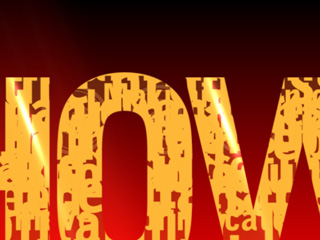By Mike Efford
Audio intensifies 3D animation. It gives spatial depth and atmosphere to an animated production, fleshes out character, and generally breathes life into it. There are ways to make the most of that combined energy, to take an animation to a higher level of intensity with good audio, and that’s what we’re about to open our eyes and ears to here.
3D animation is different from footage captured on film. 3D animation is not originated automatically with audio. Sound has to be added separately, unlike video. It may sound obvious, but there are decisions to be made when combining animation with audio that are anything but.
Coordinating animation and audio is about much more than synching. Especially with stereoscopic 3D filmmaking taking us to new worlds of audiovisual experience, the two senses are being integrated in ways both subtle and spectacular.
Perceptual research in the 1960s to the 1980s was more concerned with separating the different areas of the brain rather than looking at how they integrate, reinforce and correlate to each other. It’s when “left brain” was first seen as distinct from “right brain”, and a cliché was born. These days both science and entertainment seem to be moving toward a complex integration. And that’s our challenge: integrating more and more complex sights and sounds, animation and audio, into a quality production. The following are some observations and suggestions for doing exactly that:
Visualize:
Animating IS visualizing, of course. But less obvious is another kind of visualization: “seeing” sound. Musicians sometimes refer to “tonal color” and that’s just one example of what’s possible in visualizing music. But it goes way beyond that: tempo, texture, style, and overall “feel”. It’s very intuitive and subjective, as it should be!
When browsing music tracks, for example in a royalty free production music library, try and “see” the audio. Because a visual will in fact be paired with it, it’s not a bad idea to hold a mental picture of the animation subject whether character or graphic. Start with whatever visual reference you have on hand: a storyboard perhaps, sketches, a script, or a selection of graphic style samples. Stock photo catalogs are another source. Assemble a bit of visual reference and flip through it while trolling for tracks. Then imagine, as the musical events play out in the piece, what could happen through it, alongside it, behind it, across it, etc. The value of all this is a richer integration of animation and audio, because the project has been sourced better. It has drawn upon more creative resources of the producer or sound technician.
Manage and anticipate:
Coordinate the development of audio along with motion graphics, rather than tacking it on as an afterthought. It makes for a better managed production and a better quality production, at the end of the day. But besides having to coordinate audio and visuals, a producer has to manage the related logistics of people, travel and gear. How to help it all flow together?
- Consider starting with a music track or sting, and building the animation to fit the audio. This process works especially well with motion graphics because animated events can be fine-tuned to match an existing piece of music with great accuracy.
- Build around the most difficult elements to replace, if time is the biggest factor dictating the production. An elaborate special effects explosion shot in real time will dictate the corresponding audio effects paired with it. And a voice over reading from a very famous actor who is now out of the country is locked in. Animate around the sound.
- Spot the audio track before animating, obviously, but care needs to be taken to get this correct and accurate. After Effects, for example, will often place markers with a small lag behind the keystrokes that initiate them on the timeline track, and need to be tweaked to get them right.
- If a motion graphic animation must be developed in advance of selecting a music track, time the animation’s events and keyframes to the nearest second, and largest increments thereof; ½, 1/3 and ¼. Music tends naturally to be subdivided that way (think of the harmonic overtone series if you have a musical background), and building an animation to those generic cue points will create a very editor friendly piece of footage. That will yield the strongest synch for the least amount of upfront planning. And it can help rescue an animation production that is either extremely rushed or subject to many changes.
Innovate:
Push your stock music and sound effects into new dimensions. Starting with this very site, there’s a huge variety of royalty free sound effects, royalty free music and techniques to extend the range of stock media:
- When searching for sound FX to match an animation, try a more random search, temporarily bypassing categorizations of sounds, to find music and FX you may never have thought of.
- Make the most of an editor’s or sound technician’s skill set. They can punctuate an audio track with a wild range of sound effects, to build out a piece of stock music into something well above and beyond the original track.
- Take the music and sound effects “out of the box”: When designing audio where the important element is the virtual space in the animation where the sound will be playing, set up speakers in a similar a real – world space, play the audio and record. This can be great for unanticipated ambient sound. Brings the “audio space” to life; for example music playing in an old dance hall, with all its ambient noise and unique acoustics.
- Take both visual and audio elements and post — process them. Most top 3D animation studios never use rendered footage as is. It’s always tweaked for color balance, and often wildly altered with special effects plug-ins. Likewise, alter pitch in the audio and try filters and effects in the edit suite as well, for a more creative range of texture and tone.
Separate:
Three dimensional sound design is to be sought after, and multichannel sound mixes are the future. Audio combines with 3D animated objects on screen into a richer perception of 3D space, quite apart from providing mood etc. Having said that, one of the keys to creating depth in 3D animation is to separate one object from another, both visually and aurally. “Auditory localization” effects from the audio separation will strengthen visual depth perception in 3D animation.
- Objects that are deeply separated in 3D virtual space need to have separate audio tracks where feasible. Separation of specific objects in an animation and their corresponding audio signals makes audiences more sensitive to even tiny changes in scene environment and improves object identification. For example a cartoon character walking left to right through a raucous crowd will carry the audience’s attention with it more easily if the character’s voice crosses channels, despite the distraction of the crowd.
- With progress come new challenges, of course. For example, care must be taken, particularly for multichannel HD broadcast to use LFE, or the Low Frequency Effects channel, properly. Sending the entire audio mix through the LFE channel can create mush. That channel is intended for discrete use of the lowest ranges. Sending only the lowest frequency audio through the LFE channel will strengthen the spatial sense of that low range audio. So a giant cartoon bowling ball crashing through the floor will have a specific spatial identity and character rather than just a generic assault on the senses.
- Assigning a specific range of pitch in the audio to an individual graphic object or character in an animation can separate the paired animation/audio element from a busy environment, and direct an audience’s attention to it. A cartoon bird emitting high-pitched song will stand out from a forest full of dancing, singing animals far better than the same bird chirping with a deeper voice. The same applies to motion graphics. Play the graphic animation example and note how certain tones tend to highlight specific graphic elements.
Layer:
Layering up 3D animation elements to fit audio and vice-versa will strengthen both. As animation has grown in sophistication, it has become more complex. And the most efficient way to build up a complex production is by an additive process. Begin with the basic track or audio, then add detail. This is true for visuals as well as audio:
- Motion graphic events can be layered up to fit a music track in great detail. 3D virtual lights can be added, subtle washes of transparent color introduced and graphic elements combined, to “pull” the most out of the music. Subtle internal harmonies within a music track are given a presence, and have accompanying visual effects. When a number of audio and visual synchronizations are woven together, a motion graphic animation really takes on a life of its own and becomes something of a force of nature.
- Sound effects can extend the range of a piece of music, adding emphasis and punctuation. This is a double play, because there is a kind of perceptual feedback from the visual event sequence that reinforces the audio track when certain kinds of audio “punctuation” are added on.
Integrate:
Ultimately it all has to flow together seamlessly. An orchestra is a good example. Many different instruments modulating together in a symphony, some separating from the rest briefly, but integrating into the musical score as a cohesive whole. Animation and audio should orchestrate together too:
- As mentioned before, adding in sound effects at the right time can enhance a piece of music in its details. But overall, they can also “knit” the whole animated scene together, too. Timed to certain main keyframes in an animation, sound effects, whether for motion graphics or cartoons, can introduce periodic moments that affirm the linkage of audio and animation, making both stronger.
- Choosing a great audio track as early as possible is one key to integrating the visual with the musical. The earlier an animator has access to a music score or audio track, the more the audio can influence their thinking, and the better the animation. And no better place to start than right here, at Shockwave-Sound.com.
Video example:
Since there’s nothing better than a case study to illustrate a process, let’s take a look and have a listen to a good example of the above concepts:
The animation in action: projected onto large screens at a conference in Orlando, Florida, designed by Blackbox Communications, Toronto, Canada.
Particularly interesting with the animation we have here is that it’s basically abstract. It’s a motion graphic animation. That is, there is no animated cartoon character etc. that would provide an obvious rationale for music and sound FX selection. So, how to proceed?
Here’s how producer Melissa Elliott of Blackbox Communications in Toronto, Canada approached it:
“Our initial objective in creating this piece was to settle an audience and set a tone for a live event. We wanted a short, smart, energetic piece that conveyed a brief overview of the corporate messaging to give an audience of 3000 a visual reminder of why they were attending the event.
One of the main challenges within this piece was that we had to convey our emotion and content within a very short timeframe. If the piece went over 30 seconds, we failed in what we were trying to accomplish. The animation was to play multiple times during a 3 day conference, as an aural and visual cue to the audience that we were about to begin, so we felt that anything over 30 seconds would significantly decrease its power to engage.
With this challenge in mind, we started with the music selection. It was key to choose a track that got us to our desired emotive destination quickly, but not so quickly that the animated corporate content got missed.
Once we had a track that we felt could accomplish this, it was sent to our animator for feedback. If he could visualize the same type of animation that we could, we had a winner. If the track didn’t work for him, the search would begin again.
He put together a draft version that illustrated how the two elements were merging. We went back into the audio studio to clean up the audio to match this draft and sent the revised .aif files off so that the next round could be as tight as possible, without making it feel rushed.
In the end, the ultimate timing was determined by the animation, and budget was held back in order to go back into the audio studio a third time to fine tune the timing on the track and to add SFX for the key moments in animation. This resulted in an integrated piece that energized the audience and prepared them for the days ahead, without making them feel as though layers of corporate messaging was being thrown at them to absorb.”
We have touched on some ways to take 3D animation to the next level, intensifying it and strengthening the entire production with audio. We hope you’ll refer back to this article next time an animation project comes your way.
To your success!
Design is a Toronto based animation studio, creating 3D computer animation
for clients who market business concepts, technology, architecture and consumer
products. The studio opened in November 1994 and is now one of the most
long-established practitioners of computer animation in Canada. Find out
more about him at the Mike
Efford Motion Design website. About Blackbox Communications:
From event programming to marketing communications campaigns, video to design,
Blackbox provides the process and production necessary to build a community
of brand evangelists for business-to-business and business-to-employee clients.
You may also visit their
website.










